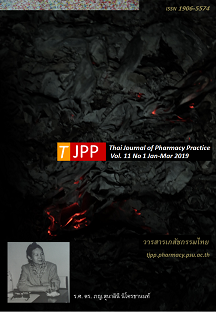ผลของการปรับชื่อยาด้วยภาษาไทยสำหรับฉลากของยาชื่อพ้องต่อความคลาดเคลื่อนในการจัดยา
Main Article Content
บทคัดย่อ
วัตถุประสงค์: เพื่อศึกษาผลของการปรับชื่อยาด้วยภาษาไทยสำหรับฉลากของยาชื่อพ้องต่อความคลาดเคลื่อนในการจัดยา วิธีการ: ยาชื่อพ้องในการศึกษา หมายถึง ยาเดียวกันที่ต่างความแรงหรือต่างรูปแบบ และยาต่างชนิดกันแต่ชื่อยาคล้ายกัน ผู้วิจัยปรับชื่อยาที่มีชื่อพ้องในโปรแกรมคอมพิวเตอร์ ทำให้สามารถพิมพ์ฉลากโดยปรากฏชื่อยาภาษาไทยเหนือชื่อยาภาษาอังกฤษสำหรับยาชื่อพ้องตัวที่มีการสั่งใช้น้อยกว่า ส่วนยาชื่อพ้องตัวที่มีการสั่งใช้มากกว่าจะคงชื่อยาเป็นภาษาอังกฤษไว้เหมือนเดิมบนฉลาก การศึกษานี้เปรียบเทียบอัตราการเกิดความคลาดเคลื่อนต่อ 1,000 ใบสั่งยาผู้ป่วยนอกในช่วงก่อนการปรับชื่อยา (30 มีนาคม ถึง 12 มิถุนายน พ.ศ. 2560) และหลังปรับชื่อยา (20 มิถุนายน ถึง 2 กันยายน พ.ศ. 2560) ผลการวิจัย: หลังการปรับชื่อยา อัตราความคลาดเคลื่อนในการจัดยาชื่อพ้องสำหรับผู้ป่วยนอกลดลงจาก 1.52 ครั้ง ต่อ 1,000 ใบสั่งยา (11,851 ใบสั่งยา) เหลือ 0.65 ครั้ง ต่อ 1,000 ใบสั่งยา (13,750 ใบสั่งยา) โดยลดลงคิดเป็นร้อยละ 57.24 และแตกต่างกันอย่างมีนัยสำคัญทางสถิติ (P=0.034) สรุป: การปรับชื่อยาด้วยภาษาไทยสำหรับฉลากของยาชื่อพ้องทำให้อัตราความคลาดเคลื่อนในการจัดยาชื่อพ้องสำหรับผู้ป่วยนอกลดลงอย่างมีนัยสำคัญ จึงควรมีการพิจารณานำวิธีการนี้ไปใช้ในการปรับฉลากของยาชื่อพ้องที่มีอยู่ในโรงพยาบาลตามความเหมาะสมของแต่ละบริบทต่อไป
Article Details
ผลการวิจัยและความคิดเห็นที่ปรากฏในบทความถือเป็นความคิดเห็นและอยู่ในความรับผิดชอบของผู้นิพนธ์ มิใช่ความเห็นหรือความรับผิดชอบของกองบรรณาธิการ หรือคณะเภสัชศาสตร์ มหาวิทยาลัยสงขลานครินทร์ ทั้งนี้ไม่รวมความผิดพลาดอันเกิดจากการพิมพ์ บทความที่ได้รับการเผยแพร่โดยวารสารเภสัชกรรมไทยถือเป็นสิทธิ์ของวารสารฯ
เอกสารอ้างอิง
2. Cohen MR, Cohen M. Causes of medication errors. Washington: American Pharmacists Association; 2007. p. 55-66.
3. Rahman Z, Parvin R. Medication errors associated with look-alike/sound-alike drugs: a brief review. J Enam Med Col. 2015;5:110-7.
4. Aronson JK. Medication errors resulting from the confusion of drug names. Expert Opin Drug Saf. 2004;3:167-72.
5. Lambert BL. Predicting look-alike and sound-alike medication errors. Am J Health Syst Pharm. 1997; 54:1161-71.
6. Berman A. Reducing medication errors through naming, labeling, and packaging. J Med Syst. 2004;28:9-29.
7. Hicks R, Becker S, Cousins D. MEDMARX data report. A report on the relationship of drug names and medication errors in response to the Institute of Medicine’s call for action. Center for the Advance ment of Patient Safety, US Pharmacopeia, Rockville [online]. 2008 [cited Jul 31, 2016]. Available from: www labatecpharma com/wp-content/uploads/2012/ 02/2008MEDMARX-DataReport pdf.
8. Chanakit T, Napaporn J, Chiempattanakajohn T, Sangkhawan S, Wichakot S. The survey of look alike/sound alike (LASA) drugs available in hospitals in Thailand. Afr J Pharm Pharmacol. 2013;7:227-39.
9. Chumchit C, Amrumpai Y, Treesak C. Recognition on medication safety and look-alike/sound-alike medication problems in Thai public hospitals. Silpa korn University Science and Technology Journal. 2015;9:40-51.
10. WHO Collaborating Centre for Patient Safety Solu tions. Look-alike, sound-alike medication names [on line]. 2007 [cited Jul 31, 2016]. Available from: www.who.int/patientsafety/solutions/patientsafety/PS-Solu tion1.pdf.
11. Emmerton LM, Rizk MF. Look-alike and sound-alike medicines: risks and ‘solutions’. Int J Clin Pharm. 2012;34:4-8.
12. Emmerton L, Rizk MF, Bedford G, Lalor D. System atic derivation of an Australian standard for Tall Man lettering to distinguish similar drug names. J Eval Clin Pract. 2015;21:85-90.
13. Filik R, Purdy K, Gale A, Gerrett D. Drug name confusion: evaluating the effectiveness of capital ("Tall Man") letters using eye movement data. Soc Sci Med. 2004;59:2597-601.
14. Filik R, Purdy K, Gale A, Gerrett D. Labeling of medicines and patient safety: evaluating methods of reducing drug name confusion. Hum Factors. 2006;48:39-47.
15. Van de Vreede M, McRae A, Wiseman M, Dooley MJ. Successful introduction of Tallman letters to reduce medication selection errors in a hospital network. J Pharm Pract Res. 2008;38:263-6.
16. Darker IT, Gerret D, Filik R, Purdy KJ, Gale AG. The influence of ‘Tall Man’ lettering on errors of visual perception in the recognition of written drug names. Ergonomics. 2011;54:21-33.
17. DeHenau C, Becker MW, Bello NM, Liu S, Bix L. Tallman lettering as a strategy for differentiation in look-alike, sound-alike drug names: the role of familiarity in differentiating drug doppelgangers. Appl Ergon. 2016;52:77-84.
18. Lambert BL, Schroeder SR, Galanter WL. Does Tall Man lettering prevent drug name confusion errors? Incomplete and conflicting evidence suggest need for definitive study. BMJ Qual Saf. 2016;25:213-7.
19. Anto B, Barlow D, Oborne CA, Whittlesea C. Incorrect drug selection at the point of dispensing: a study of potential predisposing factors. Int J Pharm Pract. 2011;19:51-60.
20. Tsuji T, Irisa T, Tagawa S, Kawashiri T, Ikesue H, Kokubu C, et al. Differences in recognition of similar medication names between pharmacists and nurses: a retrospective study. J Pharm Health Care Sci. 2015;1:19.
21. Kovacic L, Chambers C. Look-alike, sound-alike drugs in oncology. J Oncol Pharm Pract. 2011;17: 104-18.
22. Gabriele S. The role of typography in differentiating look-alike/sound-alike drug names. Healthc Q. 2005;9:88-95.
23. Schell KL. Using enhanced text to facilitate recognI tion of drug names: evidence from two experimental studies. Appl Ergon. 2009;40:82-90.
24. Chumchit CA, Yaowalak. Medication management system for medication safety in hospital: an analysis on problems and opportunity for improvement. Thai Pharmaceutical and Health Science Journal. 2009;4:127-35.
25. Ciociano N, Bagnasco L. Look alike/sound alike drugs: a literature review on causes and solutions. Int J Clin Pharm. 2014;36:233-42.
26. Ostini R, Roughead EE, Kirkpatrick CM, Monteith GR, Tett SE. Quality use of medicines–medication safety issues in naming; look‐alike, sound‐alike medicine names. Int J Pharm Pract. 2012;20:349-57.
27. Phatak HM, Cady PS, Heyneman CA, Culbertson VL. Retrospective detection of potential medication errors involving drugs with similar names. J Am Pharm Assoc. 2005;45:616-24.
28. Ashcroft DM, Quinlan P, Blenkinsopp A. Prospective study of the incidence, nature and causes of dispensing errors in community pharmacies. Pharmacoepidemiol Drug Saf. 2005;14:327-32.
29. Zhong W, Feinstein JA, Patel NS, Dai D, Feudtner C. Tall Man lettering and potential prescription errors: a time series analysis of 42 children's hospitals in the USA over 9 years. BMJ Qual Saf 2016;25:233-40.


